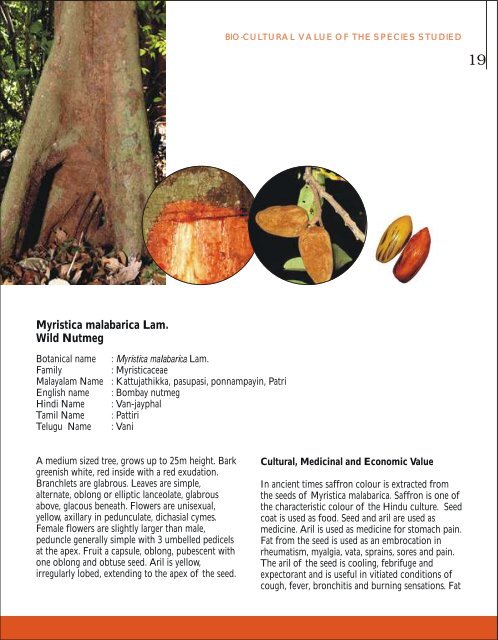Images - IUCN
Images - IUCN
Images - IUCN
Create successful ePaper yourself
Turn your PDF publications into a flip-book with our unique Google optimized e-Paper software.
Myristica malabarica Lam.<br />
Wild Nutmeg<br />
Botanical name : Myristica malabarica Lam.<br />
Family : Myristicaceae<br />
Malayalam Name : Kattujathikka, pasupasi, ponnampayin, Patri<br />
English name : Bombay nutmeg<br />
Hindi Name : Van-jayphal<br />
Tamil Name : Pattiri<br />
Telugu Name : Vani<br />
A medium sized tree, grows up to 25m height. Bark<br />
greenish white, red inside with a red exudation.<br />
Branchlets are glabrous. Leaves are simple,<br />
alternate, oblong or elliptic lanceolate, glabrous<br />
above, glacous beneath. Flowers are unisexual,<br />
yellow, axillary in pedunculate, dichasial cymes.<br />
Female flowers are slightly larger than male,<br />
peduncle generally simple with 3 umbelled pedicels<br />
at the apex. Fruit a capsule, oblong, pubescent with<br />
one oblong and obtuse seed. Aril is yellow,<br />
irregularly lobed, extending to the apex of the seed.<br />
BIO-CULTURAL VALUE OF THE SPECIES SPECIES STUDIED<br />
Cultural, Medicinal and Economic Value<br />
In ancient times saffron colour is extracted from<br />
the seeds of Myristica malabarica. Saffron is one of<br />
the characteristic colour of the Hindu culture. Seed<br />
coat is used as food. Seed and aril are used as<br />
medicine. Aril is used as medicine for stomach pain.<br />
Fat from the seed is used as an embrocation in<br />
rheumatism, myalgia, vata, sprains, sores and pain.<br />
The aril of the seed is cooling, febrifuge and<br />
expectorant and is useful in vitiated conditions of<br />
cough, fever, bronchitis and burning sensations. Fat<br />
19

















